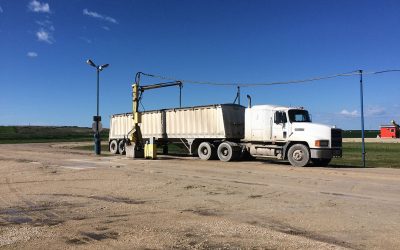Southern States plant awarded 2009 Feed Mill of the Year

A Southern States feed mill in Cleveland, North Carolina, is the 2009 Feed Mill of the Year, according to the American Feed Industry Association and Feedstuffs, the sponsors of the annual contest.
The winning feed mill was built in 1978 for FCX Inc. Southern States acquired the assets of FCX and the Cleveland mill in 1985. Last year this full-line mill manufactured 90,500 tons of feed.
The mill is certified by AFIA’s Safe Feed/Safe Food Certification Program and the Hazard Analysis and Critical Control Points system.
A total of 36 team members, including 23 production, four maintenance, four administrative and five trucking employees work at the mill managed by Mark Whitaker.
Tonnage at the mill is split between bag and bulk at 57% and 43%, respectively. The largest volumes produced are for beef, horse and poultry feed.
The marketing area of the mill is basically comprised of the Piedmont area. On the bulk side, Whitaker said the mill serves about a 150-mile radius.
The plant also makes minerals for other Southern States mills in the region and serves 96 private dealers and Southern States services owned by the company.
In total, Whitaker said, the mill produces some 480 formulas, and annual sales at the plant are in excess of $30 million.
Good candidates
The annual Feed Mill of the Year award recognizes overall excellence in feed manufacturing operations.
“The quality of this year’s candidates was quite impressive as was their dedication to quality control and safety standards,” said Keith Epperson, vice president of manufacturing and training for AFIA.
He said this year’s winning mill stood out because there is a “clear commitment from every employee to produce a safe, quality product for the customers of Southern States Cooperatives.”
Cleveland feed mill for training
The Cleveland mill has been instrumental in establishing employee training programs, to the extent even of putting together its own manuals.
“We felt like we didn’t train very well, and we wanted to go to a different level and make our training very specific, and we do it all visually,” said Whitaker.
He said he believes the renewed dedication to training has led to improved productivity and retention at the plant.
Recycling is another priority for the mill. All paper and cardboard is baled and sent to a local recycler.
Cargill Mill in Virginia is 2009 Runner-Up
A feed production operation focused solely on providing cost-effective nutrients to contract turkey and poultry growers is the runner-up in the AFIA-Feedstuffs 2009 Feed Mill of the Year contest.
The Cargill Turkey Production mill produces some 7,500 tons of finished feed per week, with the majority of that production going directly to Cargill turkey growers. The remainder of the volume goes to George’s for its local poultry-growing operations.
The Harrisonburg mill is a 24/7 operation with 25 hourly employees who have a combined average of 14 years of service, according to mill manager Grant Martin.
“Our mission is to manufacture and deliver finished high-quality feed in the most economical and efficient manner,” said Martin, who explained that the operation is focused on meeting budgeted cost-per-ton manufacturing and delivery requirements rather than on profit.
Environmental program
According to Wayne Sly, area manager, the environmental program at the Harrisonburg facility has been recognized by the state of Virginia as part of its Environmental Excellence Program.
The Harrisonburg plant operates under the ISO 14001 standard for its environmental management system.
Training at the plant includes annual reviews on dust/grain handling, welding and hot work, elevated work, confined spaces, lockout/tagout and hazard communication/chemical safety. Driver training also is emphasized.
Martin said future goals for the plant include earning Safe Feed/Safe Food program certification.
Nearly 100 feed facilities competed for this year’s award. “The number of facilities increased again this year,” said Epperson. “I believe this is due in part to the fact that each facility that applies receives important feedback in the way of bench-marking information.
“Comparing their own mill to others in the industry gives managers a way to focus on the areas where they may have scored low so they can make improvements.”











